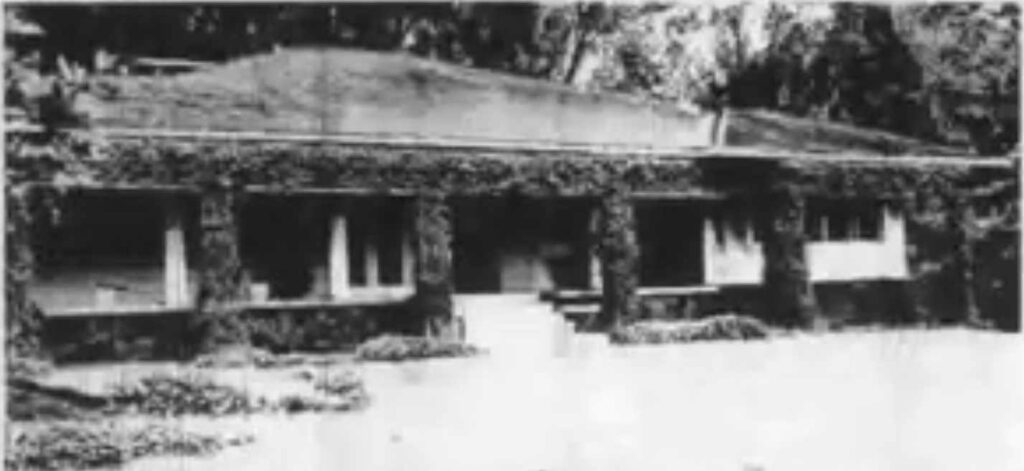This CW Dickey-designed structure was once referred to as “Honolulu’s Tropical Jewel.” (TheatresOfHawaii)
No one man has a more central place in Hawaiʻi’s architectural history than Charles William Dickey (1871-1942.) Born of a kamaʻāina family (his maternal grandfather was missionary Rev. William P Alexander,) he grew up on Maui, graduated from MIT in 1895 and practiced architecture in Honolulu from 1895 to 1904 and from 1920 until his death twenty-two years later. (Neil)
“Previous Waikīkī buildings had divided into two types: the palatial – such as the Moana Hotel and the Castle residence – and the small and informal – such as the beach house of Kamehameha V. … Dickey’s 1936 design for the Waikīkī Theater is an extreme contrast.”
“His problem was to design a 1930s movie palace which would be appropriate to Hawaiʻi. He used the expected art deco with such flair and taste that the theater compares favorably with any of the type … He then made the theater appropriate.” (Charlot)
Its initial design was based on a building at Chicago’s moderne 1933 and 1934 ‘A Century of Progress International Exposition,’ but in harmony with its island location.
The final tropical moderne design featured a large garden courtyard between the street and auditorium entrance, with lush plants surrounding a large fountain.
Inside, past fresco murals on the walls and ceiling, the atmospheric auditorium was flanked by lush artificial plants with the proscenium in the form of a rainbow, and tall artificial coconut palms on each side. (TheatresOfHawaii)
No expense was spared in its construction and furnishings. This was intended to be owner’s (Consolidated Amusement) deluxe flagship theater.
The 1,353-seat Waikīkī Theater opened with great fanfare on August 20, 1936. “This first-class theatre survived as a single-screen house its entire life.” (TheatresOfHawaii) Dickey created an environment as charming and artificial as the image on the screen. (Charlot)
In 1939, the Waikīkī Theatre was equipped with a Robert Morton theatre organ, which had originally been installed (with a twin console) in the Hawaiʻi Theatre in 1929. (Peterson)
“No theater in the world has a more picturesque setting than Waikīkī. Situated on the beach at Waikīkī, it stands on the site where once Hawaiʻi’s royalty played. The playhouse now becomes a glorious new addition to the beach made famous in song and story. It is the new center of activity of that district which long been the mecca of travelers from the world over.” (Honolulu Advertiser; Alder)
“The auditorium is a revelation in theatrical architecture. Spacious, cool, it is acoustically correct in every detail. Perfect hearing and vision are available from every seat of the huge auditorium.”
“One of the most unique ideas in theatre ‘atmosphere’ has been incorporated in the decorations. The ceiling, done in soft blue, becomes a replica of the heavens through special lighting effects.”
“Stars twinkle, soft, fleecy clouds float about, the planets send off their soft light. The Waikīkī theatre is one of the few in the world in which this unusual lighting feature has been installed.”
“Through this lighting the great rainbow that spans the proscenium becomes a soft, misty, fairy arch rivaling in loveliness the great rainbows that arch Hawaiʻi’s skies.” (Honolulu Advertiser, August 20, 1936; Del Valle)
“Inside the theater, it felt as if you were in a tropical paradise. A full-colored rainbow arched over the curtains that hid the screen. Along the side walls, there were palm trees that reached from floor to ceiling and lush jungle plants, which appeared absolutely real to my child’s eyes.”
“Then, a distinguished gentleman named Ed Sawtelle would appear and sit down at a large organ console, located just below and in front of the stage, and begin a concert that filled the hall with rolling music that vibrated off the walls.”
“About that time, with the house lights dimmed, someone would flip a switch and magical images of moving clouds would be projected onto the arched, midnight-blue ceiling, completing the illusion of having landed in the middle of a tropical jungle on a remote Pacific island.”
“Finally, the curtains would part and the show would start with a short cartoon and the Fox Movietone News. The ‘news’ events shown were about four weeks old by the time they got to Hawaiʻi, but that’s how we would find out what was happening in the world in those pre-television days.” (Richard Kelley)
After successfully celebrating its first 30+years, and as the multiplex made movie-going more competitive, in 1969 the Waikīkī Theater name was relegated to Waikīkī #3 (following the construction of the Waikīkī #1 & #2 nearby.)
Renovations in the late-60s, and remodeling a decade or so later kept the theater on life support. An expanded concession area replaced most of the forecourt, the interior decoration was removed and the auditorium draped.
“Imagine how much half an acre on Kalākaua Avenue is worth. By then, Consolidated was paying half a million dollars per year in property taxes – you have to sell a lot of popcorn to cover that.” (Lowell Angell, Theatre Historical Society of America; Hana Hou)
Waikīkī Theater (Waikīkī #3) remained a single screen theatre until it closed in late-November 2002; Waikīkī #1 & #2 closed at the same time. They demolished all three in 2005 (the demolition started about 9-years ago, today.)
“Over the years, the movie business has changed dramatically. … Multiplex theaters offer a variety of features almost any time of the day or night. Cartoons are now feature films. The news of the day is seen on one’s TV, laptop or cell phone.”
“The gracious theater usherettes have long since retired and have not been replaced. The guy at the door who takes your ticket is often dressed in a baggy T-shirt and jeans and barely looks up as he says, ’Your film will be shown in theater seven, second on the right.’” (Richard Kelley)











































